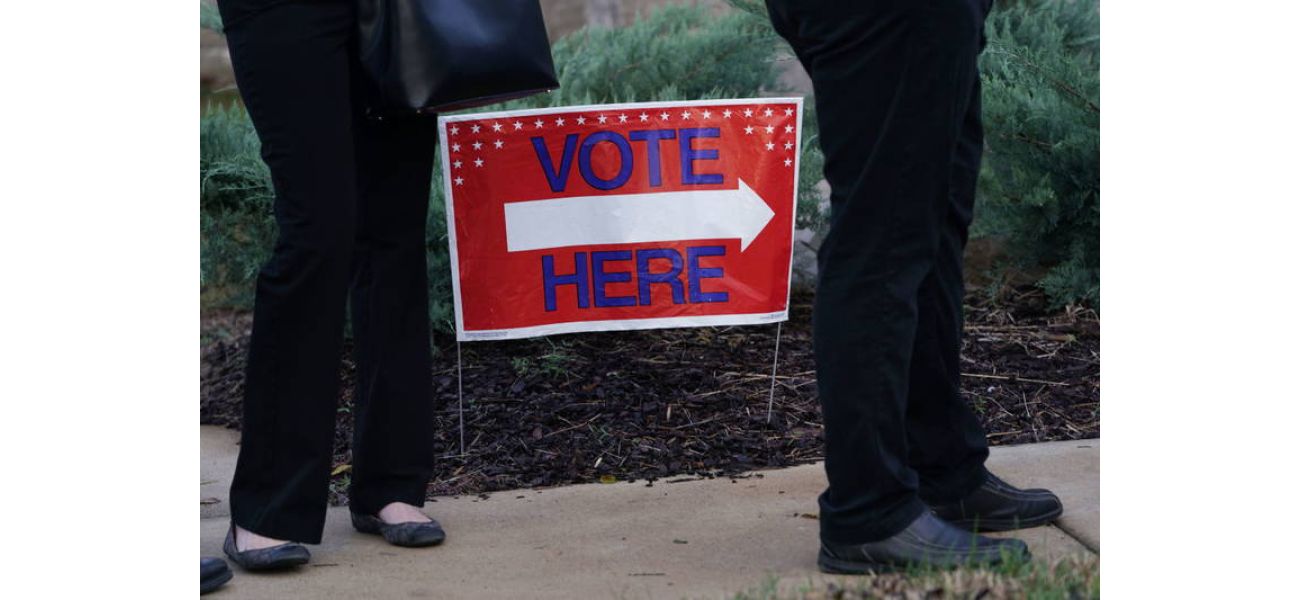Learn about the debate over maintaining accurate voter rolls with this guide.
The federal government's request for states to provide voter information exposes ongoing debates on how to safeguard voting rights while maintaining accurate voter registration.
October 6th 2025.

The recent demand from the federal government for states to hand over their voter rolls and related information has brought to light the ongoing debate over how to maintain accurate voter registration without infringing on voting rights. The U.S. Justice Department has sent letters to multiple states requesting copies of their voter lists and detailed information on how they are managed. This action is in response to federal law requirements that President Donald Trump has ordered the department to prioritize.
Currently, the Justice Department has already filed lawsuits against North Carolina and Orange County, California, for not properly verifying voter identity and refusing to provide full records for individuals who have been removed from the rolls due to potential noncitizen voting. They have also threatened to sue or withhold federal funding from other states that do not comply with their requests for information.
While everyone agrees that having a clean voter list, free of ineligible voters, is good practice, there are differing opinions on how aggressively election officials should remove potentially ineligible voters, what federal law actually requires, and how to balance election security with the risk of mistakenly removing eligible voters. This debate can become difficult to follow due to misleading rhetoric and false claims. To help clarify the issues and arguments, Votebeat has provided a guide to understanding the topic.
So, what exactly does the law require? There are two main federal laws that govern the maintenance of voter rolls. The National Voter Registration Act mandates that election officials make a reasonable effort to remove voters who are no longer eligible to vote due to changes in address or death. This process is known as list maintenance. The Help America Vote Act, enacted a decade later, requires states to maintain a computerized statewide list of registered voters and assign each a unique identification number. It also requires the removal of duplicate names.
Beyond these federal laws, it is up to state and local governments to establish their own policies for list maintenance, and it is up to federal courts to determine what is considered reasonable. However, this term is not clearly defined in the law, which often leads to disagreement between voting rights groups and advocates for stricter list maintenance.
For instance, in a recent case in Michigan, the 6th U.S. Circuit Court of Appeals ruled that the state's actions to remove thousands of deceased voters from the rolls were sufficient, despite claims from the Public Interest Legal Foundation that there were thousands more. Logan Churchwell, research director at the foundation, stated in an interview that the court's decision was only giving Michigan an "E for effort" and that there should be a higher standard to reduce the risk of fraud and administrative error. On the other hand, Lata Nott, director of voting rights policy for the Campaign Legal Center, argues that while the National Voter Registration Act sets a minimum standard for list maintenance, states should not create extreme policies that could potentially remove eligible voters.
The central issue in this debate is the level of aggressiveness in list maintenance. A recent congressional hearing highlighted the differences between Democrats and Republicans on this matter. House Republicans claim that dirty voter rolls enable fraud and that ensuring only eligible voters are registered increases election security and voter confidence. They dismiss the idea that their efforts are meant to purge certain groups of eligible voters, such as people of color. Republican Representative Laurel Lee of Florida, a former secretary of state, stated, "This is not and should never be a partisan issue. Maintaining accurate voter rolls is fundamental to election security and public trust."
House Democrats also agree that ineligible voters, such as deceased individuals or noncitizens, should not be on the list. However, they question why Republicans would take actions that could potentially disenfranchise eligible voters, citing recent incidents where eligible voters were mistakenly removed due to state list maintenance actions. Democratic Representative Julie Johnson of Texas stated, "What we do want is every eligible voter to have the chance to vote and for their constitutional rights to not be infringed upon. And that seems to be a huge distinction."
Maintaining up-to-date voter rolls is a challenging task, partly due to the decentralized nature of voting in the United States. Unlike other countries, the U.S. does not have a national database of eligible voters or citizens. Instead, states are responsible for maintaining their own lists and assigning voters a unique ID number, which is not necessarily linked to any federal identification like a Social Security number.
To remove ineligible voters, election officials rely on data from sources such as the state's motor-vehicle department, the U.S. Postal Service, and state and federal agencies for death reports. Some states also use other sources like obituaries and jury duty summonses. However, there can be gaps and time lags in these systems. For example, when people move, they often do not inform their previous election office, resulting in their name remaining on the voter list.
While it is relatively easy for officials to track in-state moves, it is more challenging to determine when someone moves out of state. This requires coordination between states or more detailed searches through government records. To assist with this, some states are members of the Electronic Registration Information Center (ERIC), a consortium that collects state voter roll data and alerts its members to potentially duplicate registrations across state lines. However, two of the largest states, California and New York, are not members, and several Republican states have withdrawn from ERIC in recent years due to concerns about the program.
There have been claims that some states have more registered voters than residents, which is often used to support allegations of voter fraud or poor state practices. However, this can be explained by federal and state laws. In some cases, state laws allow election officials to remove voters from the rolls quickly, such as when they die or respond to a jury duty summons by stating they are not a U.S. citizen. But when a state learns of a potential move, federal law requires them to send a confirmation mailing before removing the voter from the list. If the voter does not respond, they are moved to the "inactive" list and must remain there for two federal election cycles before being removed, unless the state hears from them. This four-year waiting period and a significant number of voters on the inactive list can make the voter roll appear inflated.
Another factor contributing to the disparity between registered voters and the population is the imprecise nature of population estimates. According to Chris Fowler, a professor of geography and demography at Penn State University, who studies voter rolls and census data, the U.S. Census Bureau's American Communities Survey is the best measure of population changes from year to year. However, the uncertainty in the national population count is around 10 million residents, which is roughly equivalent to the population of Michigan.
While these statistics may be used to cast doubt on the accuracy of elections and raise concerns about voter fraud, there is a valid explanation for the disparity. It is crucial to note that these numbers include inactive voters as if they were eligible voters. Before these voters can cast a ballot, they must correct their voting record, typically by providing documentation to prove their eligibility, such as showing they still reside in the jurisdiction.
In summary, the demand for states to hand over their voter rolls and related information has brought attention to the ongoing debate over how to maintain accurate voter registration without infringing on voting rights. While everyone agrees that having a clean voter list is essential, there are differing opinions on how aggressively to remove potentially ineligible voters. This issue can be difficult to navigate due to misleading rhetoric and false claims, but it is essential to understand the issues and arguments to have an informed discussion on this topic.
The recent requests from the federal government for states to hand over their voter rolls and related information have brought to light long-standing conflicts over how to ensure that only eligible voters are registered without infringing on their voting rights. This issue has been further emphasized by the U.S. Justice Department's plans to send letters to multiple states, requesting copies of their voter lists and detailed information on how they maintain them, as per federal law requirements set forth by President Donald Trump.
The department has already taken legal action against North Carolina, accusing the state of not properly verifying voter identity, and against Orange County, California for not providing full records for 17 individuals who were removed from the rolls due to a potential noncitizen voting probe. Furthermore, the department has threatened to take similar actions or withhold federal funding from other states that do not comply with their requests. While everyone agrees that maintaining a "clean" voter list is important, there are differing opinions on how aggressively election officials should remove potentially ineligible voters, and how to balance election security with the risk of wrongly disenfranchising eligible voters.
The ongoing debate has also been fueled by rhetoric and false claims from both sides, making it difficult to follow and understand the issues at hand. To help shed light on the matter, Votebeat has put together a guide to understanding the arguments and issues.
One of the main federal laws that governs the maintenance of voter rolls is the National Voter Registration Act, which requires election officials to make a "reasonable effort" to remove voters who have become ineligible due to a change in address or death. The Help America Vote Act, passed a decade later, mandates states to maintain a computerized statewide list of all registered voters and assign them a unique identification number. It also requires the removal of duplicate names.
However, beyond these federal laws, it is up to state and local governments to set their own policies for list maintenance, and it is ultimately up to federal courts to determine what is considered "reasonable". This term is not defined in the law, and it is often where voting rights groups and advocates for stricter list maintenance disagree. For example, in a recent case in Michigan, the court found the state's actions of removing the names of thousands of dead voters from the rolls to be sufficient, despite claims from the Public Interest Legal Foundation that there were thousands more on the rolls.
Logan Churchwell, research director at the foundation, stated in an interview that the court's decision was essentially giving Michigan an "E for effort". The foundation believes that there should be a higher standard to reduce the risk of fraud and administrative error. On the other hand, Lata Nott, director of voting rights policy for Campaign Legal Center, argues that while the National Voter Registration Act sets a minimum requirement for list maintenance, it does not prevent states from implementing extreme policies that may result in eligible voters being mistakenly removed.
The central issue in this debate is the level of aggressiveness in performing list maintenance. This was highlighted in a recent congressional hearing where Democrats and Republicans presented opposing views on the matter. House Republicans argued that maintaining a clean voter list is crucial for election security and voter confidence, and dismissed the notion that their efforts are targeted at purging certain eligible voters, such as people of color.
Republican Representative Laurel Lee from Florida, a former secretary of state, stated that this should not be a partisan issue and that accurate voter rolls are fundamental to election security and public trust. On the other hand, House Democrats reiterated that they also do not want ineligible voters on the list, but questioned the need for actions that could potentially disenfranchise eligible voters, citing past incidents where eligible voters were removed due to state list maintenance actions.
Keeping voter rolls updated is a challenging task, partly due to the decentralized nature of voting in the U.S. Unlike other countries, the U.S. does not have a national database of eligible voters or citizens. Instead, states are responsible for maintaining their own lists and assigning voters a unique ID number, which is not necessarily connected to any federal identification. To remove voters who are no longer eligible, election officials must find ways to track address changes, deaths, felony convictions, and other factors that may make a person ineligible to vote.
In most cases, election officials receive data on address changes from the state's motor vehicle department and the U.S. Postal Service, and death reports from state and federal agencies. Some states also use other sources, such as obituaries and responses to jury duty summons. However, there may be gaps and delays in these systems, such as when people move and do not inform the election office at their previous address.
Tracking in-state moves is relatively easy because voters maintain their state-assigned ID number when they register in a new location within the state. However, it becomes more challenging to track out-of-state moves, which requires coordination between states or thorough searches through government records. To address this issue, many states have joined the Electronic Registration Information Center (ERIC), a consortium that shares state voter roll data and alerts its members to potential duplicate registrations across state lines. However, some of the largest states, such as California and New York, are not members, and some Republican states have recently withdrawn from ERIC due to concerns about the program.
Statistics showing that some states have more registered voters than residents are often used to support claims of voter fraud or poor state practices. However, this can be explained by federal and state laws. For instance, federal law requires election officials to send a confirmation mailing before removing a voter from the rolls due to a potential move. If the voter does not respond, they remain on the list, but are moved to the "inactive" list and must stay there for four years before being removed, unless they contact the state. This waiting period and a large number of voters on the inactive list can make the voter roll appear inflated. Additionally, population estimates are often imprecise, making it challenging to accurately measure changes in population over time.
In conclusion, while the issue of maintaining voter rolls may seem straightforward, there are many complex factors at play. The ongoing debate between Democrats and Republicans highlights the differing opinions on how aggressive list maintenance should be and how to balance election security with the risk of wrongly disenfranchising eligible voters. With the decentralized nature of voting and the lack of a national database, it is a challenging task to keep voter rolls updated, which can lead to disparities and inaccuracies in the numbers. It is crucial to have a better understanding of the issues and arguments to find a fair and effective solution.
Currently, the Justice Department has already filed lawsuits against North Carolina and Orange County, California, for not properly verifying voter identity and refusing to provide full records for individuals who have been removed from the rolls due to potential noncitizen voting. They have also threatened to sue or withhold federal funding from other states that do not comply with their requests for information.
While everyone agrees that having a clean voter list, free of ineligible voters, is good practice, there are differing opinions on how aggressively election officials should remove potentially ineligible voters, what federal law actually requires, and how to balance election security with the risk of mistakenly removing eligible voters. This debate can become difficult to follow due to misleading rhetoric and false claims. To help clarify the issues and arguments, Votebeat has provided a guide to understanding the topic.
So, what exactly does the law require? There are two main federal laws that govern the maintenance of voter rolls. The National Voter Registration Act mandates that election officials make a reasonable effort to remove voters who are no longer eligible to vote due to changes in address or death. This process is known as list maintenance. The Help America Vote Act, enacted a decade later, requires states to maintain a computerized statewide list of registered voters and assign each a unique identification number. It also requires the removal of duplicate names.
Beyond these federal laws, it is up to state and local governments to establish their own policies for list maintenance, and it is up to federal courts to determine what is considered reasonable. However, this term is not clearly defined in the law, which often leads to disagreement between voting rights groups and advocates for stricter list maintenance.
For instance, in a recent case in Michigan, the 6th U.S. Circuit Court of Appeals ruled that the state's actions to remove thousands of deceased voters from the rolls were sufficient, despite claims from the Public Interest Legal Foundation that there were thousands more. Logan Churchwell, research director at the foundation, stated in an interview that the court's decision was only giving Michigan an "E for effort" and that there should be a higher standard to reduce the risk of fraud and administrative error. On the other hand, Lata Nott, director of voting rights policy for the Campaign Legal Center, argues that while the National Voter Registration Act sets a minimum standard for list maintenance, states should not create extreme policies that could potentially remove eligible voters.
The central issue in this debate is the level of aggressiveness in list maintenance. A recent congressional hearing highlighted the differences between Democrats and Republicans on this matter. House Republicans claim that dirty voter rolls enable fraud and that ensuring only eligible voters are registered increases election security and voter confidence. They dismiss the idea that their efforts are meant to purge certain groups of eligible voters, such as people of color. Republican Representative Laurel Lee of Florida, a former secretary of state, stated, "This is not and should never be a partisan issue. Maintaining accurate voter rolls is fundamental to election security and public trust."
House Democrats also agree that ineligible voters, such as deceased individuals or noncitizens, should not be on the list. However, they question why Republicans would take actions that could potentially disenfranchise eligible voters, citing recent incidents where eligible voters were mistakenly removed due to state list maintenance actions. Democratic Representative Julie Johnson of Texas stated, "What we do want is every eligible voter to have the chance to vote and for their constitutional rights to not be infringed upon. And that seems to be a huge distinction."
Maintaining up-to-date voter rolls is a challenging task, partly due to the decentralized nature of voting in the United States. Unlike other countries, the U.S. does not have a national database of eligible voters or citizens. Instead, states are responsible for maintaining their own lists and assigning voters a unique ID number, which is not necessarily linked to any federal identification like a Social Security number.
To remove ineligible voters, election officials rely on data from sources such as the state's motor-vehicle department, the U.S. Postal Service, and state and federal agencies for death reports. Some states also use other sources like obituaries and jury duty summonses. However, there can be gaps and time lags in these systems. For example, when people move, they often do not inform their previous election office, resulting in their name remaining on the voter list.
While it is relatively easy for officials to track in-state moves, it is more challenging to determine when someone moves out of state. This requires coordination between states or more detailed searches through government records. To assist with this, some states are members of the Electronic Registration Information Center (ERIC), a consortium that collects state voter roll data and alerts its members to potentially duplicate registrations across state lines. However, two of the largest states, California and New York, are not members, and several Republican states have withdrawn from ERIC in recent years due to concerns about the program.
There have been claims that some states have more registered voters than residents, which is often used to support allegations of voter fraud or poor state practices. However, this can be explained by federal and state laws. In some cases, state laws allow election officials to remove voters from the rolls quickly, such as when they die or respond to a jury duty summons by stating they are not a U.S. citizen. But when a state learns of a potential move, federal law requires them to send a confirmation mailing before removing the voter from the list. If the voter does not respond, they are moved to the "inactive" list and must remain there for two federal election cycles before being removed, unless the state hears from them. This four-year waiting period and a significant number of voters on the inactive list can make the voter roll appear inflated.
Another factor contributing to the disparity between registered voters and the population is the imprecise nature of population estimates. According to Chris Fowler, a professor of geography and demography at Penn State University, who studies voter rolls and census data, the U.S. Census Bureau's American Communities Survey is the best measure of population changes from year to year. However, the uncertainty in the national population count is around 10 million residents, which is roughly equivalent to the population of Michigan.
While these statistics may be used to cast doubt on the accuracy of elections and raise concerns about voter fraud, there is a valid explanation for the disparity. It is crucial to note that these numbers include inactive voters as if they were eligible voters. Before these voters can cast a ballot, they must correct their voting record, typically by providing documentation to prove their eligibility, such as showing they still reside in the jurisdiction.
In summary, the demand for states to hand over their voter rolls and related information has brought attention to the ongoing debate over how to maintain accurate voter registration without infringing on voting rights. While everyone agrees that having a clean voter list is essential, there are differing opinions on how aggressively to remove potentially ineligible voters. This issue can be difficult to navigate due to misleading rhetoric and false claims, but it is essential to understand the issues and arguments to have an informed discussion on this topic.
The recent requests from the federal government for states to hand over their voter rolls and related information have brought to light long-standing conflicts over how to ensure that only eligible voters are registered without infringing on their voting rights. This issue has been further emphasized by the U.S. Justice Department's plans to send letters to multiple states, requesting copies of their voter lists and detailed information on how they maintain them, as per federal law requirements set forth by President Donald Trump.
The department has already taken legal action against North Carolina, accusing the state of not properly verifying voter identity, and against Orange County, California for not providing full records for 17 individuals who were removed from the rolls due to a potential noncitizen voting probe. Furthermore, the department has threatened to take similar actions or withhold federal funding from other states that do not comply with their requests. While everyone agrees that maintaining a "clean" voter list is important, there are differing opinions on how aggressively election officials should remove potentially ineligible voters, and how to balance election security with the risk of wrongly disenfranchising eligible voters.
The ongoing debate has also been fueled by rhetoric and false claims from both sides, making it difficult to follow and understand the issues at hand. To help shed light on the matter, Votebeat has put together a guide to understanding the arguments and issues.
One of the main federal laws that governs the maintenance of voter rolls is the National Voter Registration Act, which requires election officials to make a "reasonable effort" to remove voters who have become ineligible due to a change in address or death. The Help America Vote Act, passed a decade later, mandates states to maintain a computerized statewide list of all registered voters and assign them a unique identification number. It also requires the removal of duplicate names.
However, beyond these federal laws, it is up to state and local governments to set their own policies for list maintenance, and it is ultimately up to federal courts to determine what is considered "reasonable". This term is not defined in the law, and it is often where voting rights groups and advocates for stricter list maintenance disagree. For example, in a recent case in Michigan, the court found the state's actions of removing the names of thousands of dead voters from the rolls to be sufficient, despite claims from the Public Interest Legal Foundation that there were thousands more on the rolls.
Logan Churchwell, research director at the foundation, stated in an interview that the court's decision was essentially giving Michigan an "E for effort". The foundation believes that there should be a higher standard to reduce the risk of fraud and administrative error. On the other hand, Lata Nott, director of voting rights policy for Campaign Legal Center, argues that while the National Voter Registration Act sets a minimum requirement for list maintenance, it does not prevent states from implementing extreme policies that may result in eligible voters being mistakenly removed.
The central issue in this debate is the level of aggressiveness in performing list maintenance. This was highlighted in a recent congressional hearing where Democrats and Republicans presented opposing views on the matter. House Republicans argued that maintaining a clean voter list is crucial for election security and voter confidence, and dismissed the notion that their efforts are targeted at purging certain eligible voters, such as people of color.
Republican Representative Laurel Lee from Florida, a former secretary of state, stated that this should not be a partisan issue and that accurate voter rolls are fundamental to election security and public trust. On the other hand, House Democrats reiterated that they also do not want ineligible voters on the list, but questioned the need for actions that could potentially disenfranchise eligible voters, citing past incidents where eligible voters were removed due to state list maintenance actions.
Keeping voter rolls updated is a challenging task, partly due to the decentralized nature of voting in the U.S. Unlike other countries, the U.S. does not have a national database of eligible voters or citizens. Instead, states are responsible for maintaining their own lists and assigning voters a unique ID number, which is not necessarily connected to any federal identification. To remove voters who are no longer eligible, election officials must find ways to track address changes, deaths, felony convictions, and other factors that may make a person ineligible to vote.
In most cases, election officials receive data on address changes from the state's motor vehicle department and the U.S. Postal Service, and death reports from state and federal agencies. Some states also use other sources, such as obituaries and responses to jury duty summons. However, there may be gaps and delays in these systems, such as when people move and do not inform the election office at their previous address.
Tracking in-state moves is relatively easy because voters maintain their state-assigned ID number when they register in a new location within the state. However, it becomes more challenging to track out-of-state moves, which requires coordination between states or thorough searches through government records. To address this issue, many states have joined the Electronic Registration Information Center (ERIC), a consortium that shares state voter roll data and alerts its members to potential duplicate registrations across state lines. However, some of the largest states, such as California and New York, are not members, and some Republican states have recently withdrawn from ERIC due to concerns about the program.
Statistics showing that some states have more registered voters than residents are often used to support claims of voter fraud or poor state practices. However, this can be explained by federal and state laws. For instance, federal law requires election officials to send a confirmation mailing before removing a voter from the rolls due to a potential move. If the voter does not respond, they remain on the list, but are moved to the "inactive" list and must stay there for four years before being removed, unless they contact the state. This waiting period and a large number of voters on the inactive list can make the voter roll appear inflated. Additionally, population estimates are often imprecise, making it challenging to accurately measure changes in population over time.
In conclusion, while the issue of maintaining voter rolls may seem straightforward, there are many complex factors at play. The ongoing debate between Democrats and Republicans highlights the differing opinions on how aggressive list maintenance should be and how to balance election security with the risk of wrongly disenfranchising eligible voters. With the decentralized nature of voting and the lack of a national database, it is a challenging task to keep voter rolls updated, which can lead to disparities and inaccuracies in the numbers. It is crucial to have a better understanding of the issues and arguments to find a fair and effective solution.
[This article has been trending online recently and has been generated with AI. Your feed is customized.]
[Generative AI is experimental.]
0
0
Submit Comment





